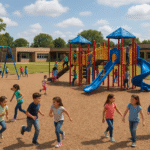AI in Education: Revolutionizing Classroom Engagement with ChatGPT
Key Takeaways:
- ChatGPT is transforming traditional classroom settings by aiding in the creation of engaging, customized learning activities.
- Educators using ChatGPT report a significant increase in student participation and enthusiasm for learning.
- The AI tool’s ability to generate diverse educational content supports various learning styles and curricular goals.
- Recent advancements in AI have made it possible for teachers to integrate ChatGPT seamlessly into lesson planning and execution.
In the rapidly evolving landscape of educational technology, ChatGPT has emerged as a groundbreaking tool for educators looking to enhance classroom engagement and learning outcomes. With its advanced capabilities, ChatGPT assists teachers in crafting customized, interactive activities that cater to diverse student needs and learning styles.
Recent Advancements and Trends in AI-Educated Classrooms
Recent developments in AI technology have significantly impacted how educational content is delivered. In 2023, several schools across the globe began incorporating AI tools like ChatGPT to assist in lesson planning and activity design, resulting in a marked improvement in student interaction and learning retention. According to a2023 Educational Technology Insight Report, classrooms utilizing AI-driven tools have seen a 40% increase in student engagement levels.
Strategies for Using ChatGPT in Classroom Activity Design
1. Customizing Learning Materials
ChatGPT can generate tailored educational content that aligns with curriculum standards and addresses individual learning needs.
- Application: Teachers can input specific topics or standards into ChatGPT, and it will suggest a range of activities—from interactive discussions to practical experiments—that enhance understanding and retention.
2. Creating Interactive Quizzes and Games
ChatGPT helps design quizzes and educational games that make learning fun and engaging, encouraging students to participate actively.
- Example: Request ChatGPT to create a quiz on historical events or a word game for vocabulary building, suitable for specific age groups or subjects.
3. Facilitating Group Work
ChatGPT can propose group activities that promote collaboration among students, critical thinking, and problem-solving skills.
- Implementation: Use ChatGPT to outline group projects or role-playing scenarios that require teamwork and creative input, such as a mock trial in a civics class or a lab experiment in science.
4. Supporting Diverse Learning Styles
With its vast database, ChatGPT can offer activities that support various learning styles, whether auditory, visual, kinesthetic, or reading/writing preferences.
- Action: Teachers can describe their classroom demographics to ChatGPT, which can then suggest activities tailored to these diverse needs, ensuring that all students are effectively engaged.
Real-World Examples of AI-Enhanced Classroom Activities
Science Education:A high school in Texas used ChatGPT to design a series of interactive experiments that students could conduct in small groups to learn about renewable energy sources. The result was a noticeable increase in student interest in environmental science courses.
Language Arts:A middle school in London integrated ChatGPT to help design creative writing exercises that involved crafting stories based on artificial intelligence. This approach not only improved writing skills but also introduced students to basic AI concepts.
Ensuring Effective Use of ChatGPT in Education
- Collaboration with Educators: It’s essential for teachers to work alongside AI tools like ChatGPT, using their professional judgment to refine and adapt the generated content.
- Regular Updates and Feedback: Continuously updating the input based on classroom dynamics and student feedback can help ChatGPT become an even more effective teaching assistant.
- Ethical Considerations: Educators should ensure that the use of AI in the classroom upholds educational integrity and promotes positive learning environments.
Conclusion
ChatGPT represents a transformative development in the field of education, offering dynamic and innovative ways to engage students. As AI technology continues to evolve, its integration into educational settings promises to enhance teaching methodologies, making learning more interactive, enjoyable, and effective. The future of education is here, and it’s powered by AI, providing educators with powerful tools to shape young minds in the digital age.













